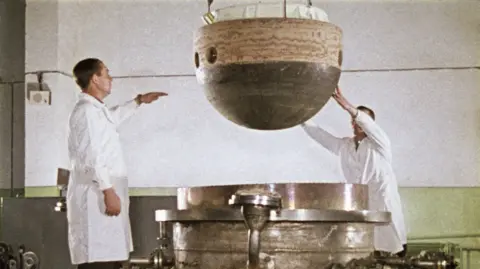Local weather & Science reporter
 Getty Photos
Getty PhotosA part of a Soviet-era spacecraft is more likely to have re-entered the Earth’s environment after being caught in orbit for over half a century, the European Area Company stated.
Kosmos 482, which launched in 1972 on a mission to Venus, by no means made it out of Earth’s orbit and as an alternative broke into 4 items which were circling the planet for over 5 a long time.
The EU Area Surveillance and Monitoring centre (SST) stated one fragment – believed to be the lander – “almost certainly” re-entered the environment at about 06:16 GMT (07:16 BST) on Saturday.
It’s unclear whether or not the item fell to the bottom or burned up within the environment.
Additionally it is unclear precisely the place the item re-entered the environment.
Whereas there may be a lot consultants have no idea in regards to the object’s re-entry, 70% of Earth is roofed by sea so it’s unlikely to have prompted important harm.
“It is more likely that you just win the lottery than that you just get impacted by this piece of area particles,” Stijn Lemmens, a senior analyst on the European Area Company, stated.
Kosmos 482’s lander capsule was constructed to outlive the intense warmth and strain of Venus’s environment, that means it had a strong warmth protect and sturdy construction.
That is why consultants suppose it could have survived an uncontrolled descent via Earth’s environment.
Nevertheless, Kosmos 482’s parachute system, initially meant to gradual the lander’s descent in the direction of Venus, is more likely to have degraded after greater than 50 years in area.
Mr Lemmens defined that the “re-entry of human-made objects into Earth’s environment happens fairly ceaselessly”. He stated it occurs weekly for larger spacecraft and each day for smaller ones.
Objects usually fritter away within the earth’s environment earlier than they attain the bottom.
China’s Lengthy March 5B booster re-entered over the Indian Ocean in 2022, and the Tiangong-1 area station largely burned up over the Pacific in 2018.
Kosmos 482 is now being carefully tracked by worldwide area companies.
Mr Lemmens stated that future spacecraft “needs to be designed in such a manner that they will take themselves out of orbit safely, ideally by doing managed re-entries”.
This could permit for exact predictions of touchdown places, decreasing the danger of any particles impacting populated areas and defending individuals and property whereas “managing the environmental influence of area particles”.
Local weather & Science reporter
 Getty Photos
Getty PhotosA part of a Soviet-era spacecraft is more likely to have re-entered the Earth’s environment after being caught in orbit for over half a century, the European Area Company stated.
Kosmos 482, which launched in 1972 on a mission to Venus, by no means made it out of Earth’s orbit and as an alternative broke into 4 items which were circling the planet for over 5 a long time.
The EU Area Surveillance and Monitoring centre (SST) stated one fragment – believed to be the lander – “almost certainly” re-entered the environment at about 06:16 GMT (07:16 BST) on Saturday.
It’s unclear whether or not the item fell to the bottom or burned up within the environment.
Additionally it is unclear precisely the place the item re-entered the environment.
Whereas there may be a lot consultants have no idea in regards to the object’s re-entry, 70% of Earth is roofed by sea so it’s unlikely to have prompted important harm.
“It is more likely that you just win the lottery than that you just get impacted by this piece of area particles,” Stijn Lemmens, a senior analyst on the European Area Company, stated.
Kosmos 482’s lander capsule was constructed to outlive the intense warmth and strain of Venus’s environment, that means it had a strong warmth protect and sturdy construction.
That is why consultants suppose it could have survived an uncontrolled descent via Earth’s environment.
Nevertheless, Kosmos 482’s parachute system, initially meant to gradual the lander’s descent in the direction of Venus, is more likely to have degraded after greater than 50 years in area.
Mr Lemmens defined that the “re-entry of human-made objects into Earth’s environment happens fairly ceaselessly”. He stated it occurs weekly for larger spacecraft and each day for smaller ones.
Objects usually fritter away within the earth’s environment earlier than they attain the bottom.
China’s Lengthy March 5B booster re-entered over the Indian Ocean in 2022, and the Tiangong-1 area station largely burned up over the Pacific in 2018.
Kosmos 482 is now being carefully tracked by worldwide area companies.
Mr Lemmens stated that future spacecraft “needs to be designed in such a manner that they will take themselves out of orbit safely, ideally by doing managed re-entries”.
This could permit for exact predictions of touchdown places, decreasing the danger of any particles impacting populated areas and defending individuals and property whereas “managing the environmental influence of area particles”.















